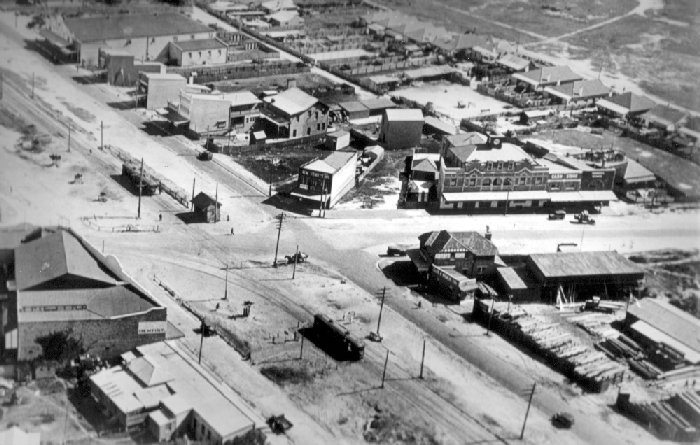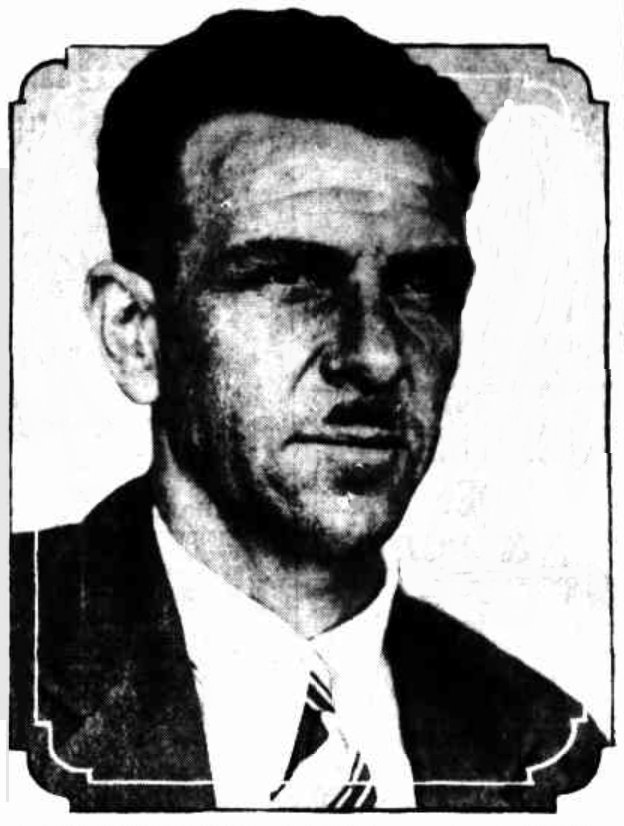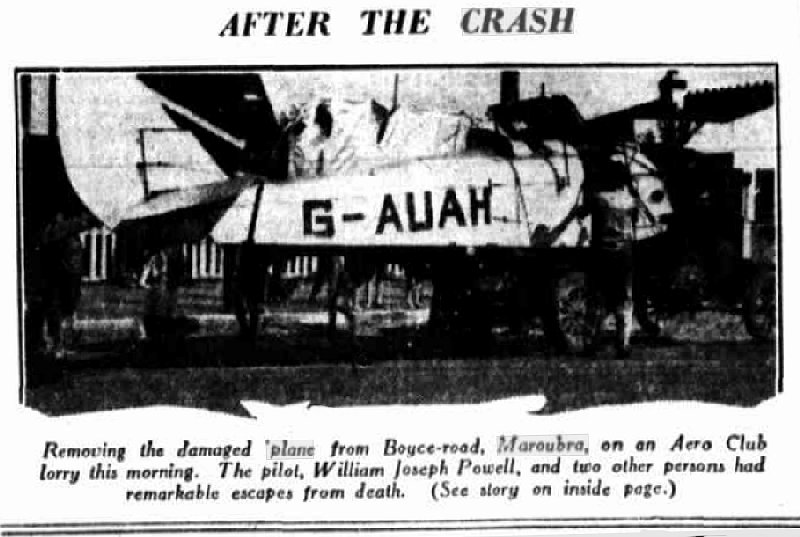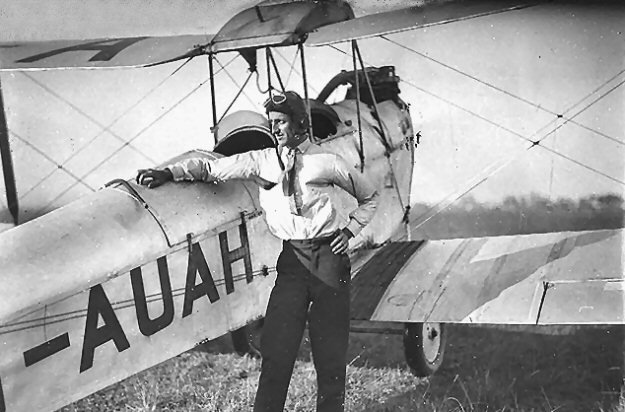Maroubra Plane Crash
Sensational 1930 Incident
On a morning in March 1930, the quiet suburban streets of Maroubra were shattered by the roar of an aeroplane engine struggling to gain height.
The aircraft plummeted to the ground near the corner of Boyce Road and Anzac Parade. The pilot, pulled from the wreckage with injuries,
was fortunate to survive. Meanwhile, a seemingly uninjured passenger surveyed the gathering crowd of rescuers before fleeing on foot.
Onlookers found the scene mysterious but were relieved that no one was critically injured. Tragically, later that day, a lineman repairing
downed power lines was accidentally electrocuted and died.

Aerial view of Maroubra Junction, c1930
Aviator William Powell
William Joesph Powell, aged 31, began his flight about 7 a.m. at Mascot Aerodrome on Saturday 22 March, 1930 in a Gypsy Moth bi-plane (G-AUAH).
owned by the Australian Aero Club. He said later that the engine cutout over Maroubra Post Office (corner of Maroubra Bay Road and Anzac Parade). He
said that he tried to steer the machine to vacant land but that it crashed near the Boyce Road intersection, narrowly missing an oncoming car before coming down on Anzac Parade,
pulling down of mass of telephone lines in its wake.

William Joseph Powell, newspaper photograph from Truth in 1932
Powell was a mechanic and worked at his father's motor repair garage which just happened to be very near where his plane had come down. So near to his business, that his own
young son ran from the motor repair building calling "There's Daddy coming down, I'll go catch him". Powell seems to have hankered to
be an aviator. He had begun flying in November 1929 and had 18 hours dual and 16 hour solo flying under his belt. Though just a beginner and yet without pilot's licence, he had been in the habit of making early morning flights over Maroubra.
When the machine left the Mascot aerodrome, Aero-Club officials stated that Powell was unaccompanied, and, furthermore, was not
licensed to take passengers. Yet witnesses said at the crash site, a passenger clambered from the 'plane, and after ascertaining the nature of Powell's injuries,
fled from the scene through the large crowd that had gathered. Since Powell crashed at about 9am and that it would normally only take a couple of minutes to fly
from Mascot, the inference was that Powell had flown elsewhere, landed, picked up an authorised passenger, and headed to Maroubra to "show off" to people
he knew at his place of business.
Powell was taken by ambulance to Royal South Sydney Hospital suffering from concussion and spent three days in hospital.
Passenger Howard Firkin
The passenger turned out to be Howard Thomas Firkin. In later, 1933, newspaper reports about his divorce from his wife, it can be learnt that Firkin was a commercial artist
and decorator who was born in Christchurch, New Zealand and was about 23 years old. He lived with his wife at Milson's Point until December 1930, when he moved to the
Hunter region. It was said that he was interested in aviation and frequently went to Mascot Aerodrome, sometimes with his wife. There they would both try to acquire aircraft flights.
Firkin would turn up to visit Powell in hospital the next day with a black eye and abrasions to one leg.
Between them, Powell and Firkin gave varying accounts of what happened to the press. Powell said at one stage that he was practising forced landings by aiming for a flat area known as "Labor Farms",
in another account the engine had cut out unexpectedly, or that on the flight the engine had been behaving eratically and he had hoped to nurse it back to Mascot.

Damaged Gypsy Moth loaded onto lorry - newspaper report from Sydney Sun
Tragedy
Later, 47-year-old linesman, John Percy Noble of Collins Street, Botany was called to repair the damaged caused by the plane crash. While onlookers milled around
watching the wreckage of the plane being cleared away, they were horrified to hear a commotion as Noble, who had climbed about 20 feet up a power pole to begin
repairs, was accidentially electrocuted and toppled over backwards. His belt saved him from falling to the ground, but blood gushed from terrible wounds on his hands and arms. Another linesman
managed to kick him away from the live wires and he was bought to the ground. Unfortunately, telephone communications had been cut by the plane crash, and it
took some time to call an ambulance to take him to the Coast Hospital at nearby Little Bay. Tragically, Noble succumbed to his injuries and died in the
hospital the next day. Noble was buried in the Anglican section of Botany Cemetery on 27th March 1930.
Wonder of the Age
The de Havilland DH.60 Moth, commonly known as the Gypsy Moth, was a marvel of 1930s aviation with a top speed of 102 miles per hour. This biplane, with its lightweight
design and reliable Gipsy engine, revolutionized personal and commercial flight. Its performance was remarkable for the era, offering a blend of agility, stability, and ease of
handling that made it a favourite among pilots. Its ability to take off and land in short distances created new possibilities for air travel, making remote areas accessible and fostering
the growth of aviation clubs and flight school. Its iconic status was cemented by pioneering aviators like Amy Johnson, who flew solo from England to Australia in 1930,
showcasing the aircraft's endurance and reliability. The Gypsy Moth was a technological achievement and symbolized a spirit of adventure and the boundless potential of human ingenuity.

Aviator Goya Henry with Gypsy Moth later flown by William Powell
This photograph, by Sam Hood, from the State Library of New South Wales, shows colourful aviator Goya Henry after winning the second semi-final of an Air Race, circa 1929.
G-AUAH at the time would have been registered to the Civil Aviation Branch, Department of Defence, and on loan to the Australian Aero Club (NSW section) at Mascot.
The aircraft had chequered career being involved in several accidents, including the incident at Maroubra and the last a crash into the sea at
Ettalong Beach NSW in 1941. The remains were sold in an unairworthy condition to a V. Burgess in 1942 although the aircraft never regained a Certificate of
Airworthiness and was stricken from the register in 1945.
Consequences
Between them, Powell and Firkin gave
varying accounts of what happened to the press. Powell said at one stage that he was practising forced landings by aiming for a flat area,
in another account the engine had cut out unexpectedly.
Powell would later claim that rather than land mid-flight to pick up his passenger, though he had left the hangar unaccompanied, he had come across a friend at
the end of the runway who was keen to experience an aircraft ride, and he welcomed him aboard for the flight.
When the matter came to court in June later in 1930, the magistrate was unequivocal in his judgement declaring that Powell was to blame and should not have been
carrying a passenger. Powell "had been stunting over his own garage.
Powell was fined £10 with £6, 13 shillings in costs.
Luckily for Powell and Firkin, there was no consequences for the death of linesman Noble. That was a later accident for which they were not blamed.
Suicide of Mrs Elsie Hoad
Tragedy had a habit of following William Powell. At a January 1932 inquest into the suicide death of a Mrs Elsie Hoad, Powell was described as a widower with
three children aged six, nine and eleven who were cared for by Powell's mother with whom he lived. It was said that about 2 1/2 years previously he met a young woman
then known as Elsie Brown (this must have been some months before his airplane crash). They became lovers, but after about six months, Powells affection for Miss Brown
wavered and he broke off contact. Miss Brown then married a Richard Hoad who lived at nearby Kensington, and they lived at 107 Doncaster Avenue, Kensington. However,
Elsie's romantic fervour for Powell seems to have remained and, according to Powell, continued to try and see him, despite him having met another younger woman to whom
he was now engaged.
About 9 o'clock on December 14, Elsie visited Powell at Powell's Garage, Maroubra Junction. Powell claimed that Elsie had threatened self-harm on other occasions without
following through, so he was unconcerned on that evening about any threats she was making. The police were Informed by Powell that after he and Elsie
been talking for an hour and a half, she asked him to get her a drink of water. When he refused, she got one herself, and immediately was seized with convulsions.
Tho doctor diagnosed her case as strychnine poisoning.
Backed out of Suicide Pact?
Investigating the circumstances surrounding the death of Elsie Annie Hoad, who ingested poison at Powell's Motor Garage at Maroubra on December 14, the City Coroner, Mr. May, sharply
criticized William Powell's involvement in the incident. Mr. May expressed his belief that there was a death pact between Hoad and Powell, asserting that she took the poison
in his presence and that he was too cowardly to fulfil his part of the agreement.
"I do not intend to let him go scot-free. His name shall be recorded on my finding into this woman's death, to remain there for all time."
|
Elsie was laid to rest at the Eastern Suburbs Memorial Park (Botany Cemetery), Anglican Section FM D, Position 0454. The coroner's verdict concluded that Elsie Hoad
had died from strychnine poisoning, which she had wilfully self-administered in the presence of William John Powell, who was fully aware that the poison was easily
accessible to her. Powell, however, later told the Truth newspaper that he strongly objected to the coroner's harsh remarks and would do everything in his power to clear his name.
Hero or Villain?
As the dust settled on the sensational events of March 1930, William Powell's life remained a tangled web of intrigue and tragedy. From the dramatic plane crash that nearly
claimed his life to the mysterious passenger who vanished into the crowd, Powell's story was one of daring and defiance. Yet, the shadow of Elsie Hoad's tragic death cast the
longest pall over his reputation. Despite his protests and the coroner's damning verdict, Powell's name would forever be entwined with the dark whispers of a suicide pact unfulfilled.
In the annals of Maroubra's history, the tale of William Powell stands as a testament to the perilous dance between ambition and fate, where the line between hero and villain is often blurred.
References & Notes
'After the crash', The Sun (Sydney), 22 March 1930, Page 1
'Plane Crashing Into Street Narrowly Misses Overwhelming Motorist' The Sun (Sydney), 22 March 1930, Page 5
'Plane crashes', The Sydney Morning Herald (NSW), Mon 24 Mar 1930, Page 12
' Sensational Sequel to 'Plane Crash in Maroubra Street' Evening News (Sydney), Sat 22 Mar 1930, Page 1
'Plane crashing into street narrowly misses overwhelming motorist', The Sun(Sydney), Sat 22 Mar 1930, Page 5
'Left Husband [Howard Firkin]', The Maitland Daily Mercury (NSW) Thu 6 July 1933 , Page 7
http://www.edcoatescollection.com/ac1/austu/G-AUAH.html
'From Mascot: crash victim explains his passenger', The Sun (Sydney), Mon 24 Mar 1930, Page 10
'Joke Was Nearly a Tragic Prophecy' The Sun (Sydney), Sun 23 Mar 1930 Page 2
'Pilot fined £10', Evening News (Sydney), Tue 3 June 1930, Page 9
'Garage death pact', The Daily Telegraph, Sat 9 Jan 1932, Page 1
'Poisoned', The Sun (Sydney) Tue 15 Dec 1931, Page 13
'Denies he turned back from death's door', The Truth (Sydney), Sunday 10 Jan 1932, p.11
Copyright © Coogee Media All rights reserved
|



